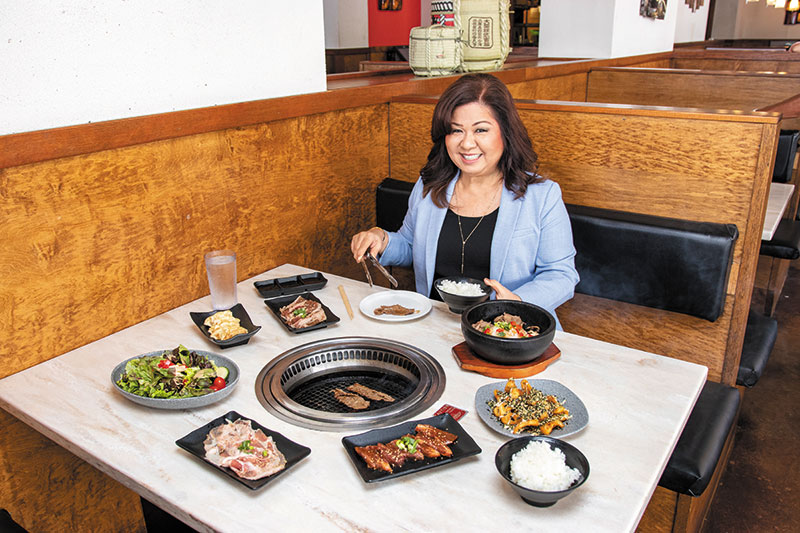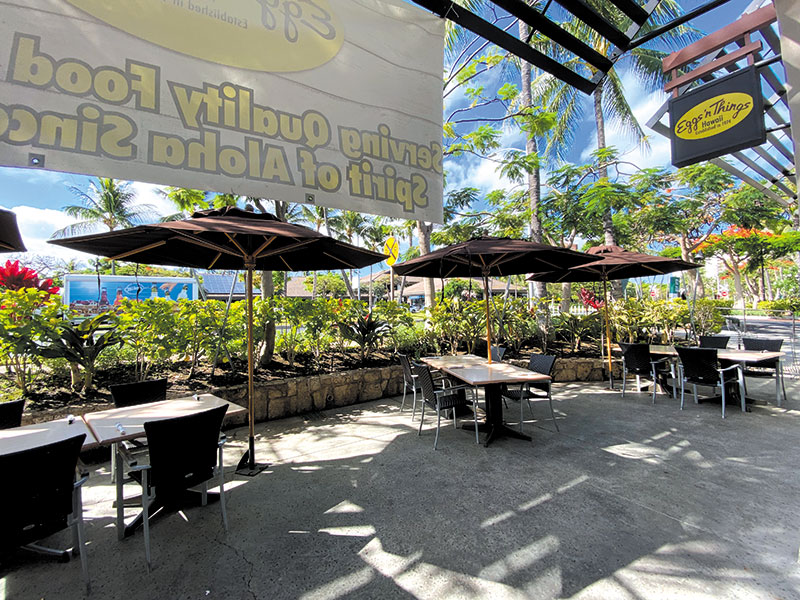At Your Service

Hawai‘i Restaurant Association executive director Sheryl Matsuoka says “our restaurants are ready” to get back to business. MARK GALACGAC PHOTO
With dine-in restrictions lifted, restaurants are once again serving customers — and doing it safely.
Appetites around the state are ramping up with the latest talk of the town: Restaurants reopened for dine-in services June 5 — with adjustments, of course.
Leading the effort to help eateries reopen and adhere to federal, national and local safety guidelines is Hawai‘i Restaurant Association, a unifying force for the state’s food service industry.
“It’s a very difficult task,” says HRA chairman Tom Jones, who also is president and co-owner of REI Food Service LLC. “But if the governor and his administration can come up with a tiered process to prescreen tourists and keep Hawai‘i’s COVID-19 infection rate at or near zero, the state would be one of the most sought-after vacation destinations and worth the wait.”
Jones and the rest of the Hawai‘i Restaurant Association team have been hard at work for its dining members, compiling advice and recommendations from federal organizations like the Centers for Disease Control and Prevention, Environmental Protection Agency, and Food and Drug Administration, as well as state and local government officials to set forth specifications for safe and efficient reopenings. (Visit hawaiirestaurant.org for more details.)
“We want you to feel safe,” assures Sheryl Matsuoka, executive director of HRA. “Restaurants and food have the strictest guidelines and the highest standards of sanitation safety. A lot of restaurants just want to open.”
Regulations regarding wearing a mask (except when eating) and keeping 6 feet apart have been standard as of late, but there are new changes that will be implemented, as well.
Pre-COVID-19, utensils would be arranged nicely on the table and condiments placed off to the side for easy access. Now, though, all that has changed. Patrons will have the option of wrapped disposable forks, knives and spoons, or sterilized metal ones. Passing around a bottle of ketchup at the table won’t be an option anymore. Now, individual packets and small containers will be given out.
Menus also come with some modifications. Flipping through a pages-long booklet will be a thing of the past. If not disposable, some restaurants are using apps and QR codes to virtually showcase their menus.
“Some restaurants are even putting those acrylic shields up,” adds Matsuoka. “What’s come out of it is a lot of creativity.”
That’s not to say that takeout isn’t still important during this time, especially for those restaurants that won’t be offering dine-in services.
“A lot of them did pivot,” Matsuoka continues. “That’s the big word.”
Indeed, local eateries have changed the way they operate to produce meals safely and cater to the changing landscape of how Hawai‘i eats. More are offering delivery services and curbside pickup options, and others are changing their menus to cater to a wider range of clients. HRA has an extensive online list of Hawai‘i restaurants that needs the support of the public: hawaiirestaurant.org/member-directory.
Family pack meals that feed larger families and main dishes in bulk containers are now the linchpin on many restaurant menus.
“They’ll pack your appetizers all the way to dessert in a box,” Matsuoka explains. “Those kinds of ideas have emerged because of this pandemic. Creative ideas.”
And it’s not just about the food, either. Hawai‘i Restaurant Association was also instrumental in working with Gov. David Ige to allow restaurants to serve sealed spirits. It’s a benefit for patrons, who now can add on their favorite libation to accompany their meal, as well as restaurants, which profit from the added sale.
Picking up meals from local restaurants is just one way to support them during this time. Purchasing gift cards for future use is yet another avenue that people can follow to help out.
The switch to solely serving takeout might not have been enough for some of Hawai‘i’s restaurants, specifically the small local eateries. Even with the forthcoming reopening, the future looks uncertain for some.
A study conducted by The Economic Research Organization at the University of Hawai‘i (UHERO), found that 7 percent of operators anticipate permanently closing their restaurant within the next 30 days.
“These are probably small mom-and-pop shops,” Matsuoka adds. “It’s been more than two months, and a lot of them without any income can’t survive while they have to pay their rent and all of the business expenses. That’s what’s really heartbreaking.”
“After gaining consumer confidence and getting our customers back to 2019 levels, the most pressing medium term problem for restaurants is going to be meeting lease and rent payments that were negotiated pre-pandemic,” Jones adds. “Without substantial adjustments to most leases, restaurant owners will be struggling to stay afloat.”
Now that dine-in service will be starting up this week, HRA and restaurants around the state are looking forward to serving up delicious food for more clientele.
“The governor said June 5, and we are ready,” concludes Matsuoka days before the slated reopening. “Our restaurants are ready.”







